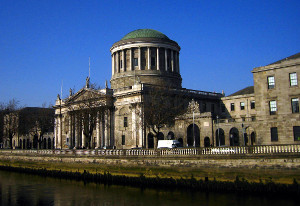High Court: Environmental group fails in application for attachment of Roscommon County Council CEO

The High Court has refused an application by an environmental group for the attachment of the chief executive for Roscommon County Council. The group claimed that the County Council had breached a court order by restarting work on a flooding relief program.

About this case:
- Citation:[2021] IEHC 666
- Judgment:
- Court:High Court
- Judge:Mr Justice Garrett Simons
However, Mr Justice Garrett Simons held that there was no breach by the County Council of the previous court order. It was held that the Council had obtained consent for further works on a different statutory basis and it had not been intended in the original order to exclude that possibility.
Background
Roscommon County Council had previous undertaken works for flood relief at Lough Funshinagh which was designated as a Special Area of Conservation under EU law. The Council sought to “sidestep” the procedural obligations of the EU Habitats Directive and the Environmental Impact Assessment Directive under the provisions of the Local Authorities (Works) Act 1949.
Subsequently, Friends of the Irish Environment clg (FIE) took judicial review proceedings seeking to quash the decision. On 25 August 2021, a consent order was agreed between the parties, where the decision to authorise the flood relief works was quashed. It was also agreed by the parties (and reflected in the court order) that the Council would remediate the lands in question.
The remediation involved a section of pipe of about 800 metres. The remediation plan envisaged that the pipe would remain in situ and would be sealed by the installation of end caps. Further, open trenches were to be backfilled using excavated material and the manholes in the pipe would be capped with concrete and backfilled.
The remediation was substantially completed by 18 October 2021. However, the chief executive later authorised emergency flood relief works at the site which were “significantly scaled back” from the original proposal. The order was made pursuant to section 151 of the Local Government Act 2001 on 14 October 2021.
The chief executive’s order recorded that there would be no significant effect on a European site and accordingly, an application to An Bord Pleanála was not necessary. The emergency works would use the same section of pipe in the previous plan and would involve undoing some of the remediation work.
It was contended by FIE that these actions were a clear breach of the previous High Court order made on 25 August. It was said that the remediation works had to be implemented in full unless the court order was varied by application of the Council.
It was also said that the court order did not contain any temporal limitation which allowed the works to be undone either at a defined point in time or on the occurrence of a future event. It was noted that the original order granted the parties liberty to apply, but this had never been done by the Council.
High Court
First, the court outlined the proper legal test to determine if there had been a breach of a court order. The court approved of the test outlined in P. Elliott & Company Ltd v. Building and Allied Trades Union [2006] IEHC 340, which stated: “Would a reasonable and informed person, having had sight of the court order, come to the view that the acts complained of were legitimate having regard to that order?”
The court then moved to consider whether there had been any breach of the court order from 25 August 2021. It was held that if there was any doubt or ambiguity regarding the correct interpretation of the order, then the benefit of the doubt would have to go to the chief executive.
It was noted that the original decision had been made under the 1949 Act, which had not been amended to properly reflect the State’s obligations under EU law. The court said that the original works would normally require a screening and assessment pursuant to the relevant Directives.
The court held that the original order did not address the current situation, where a smaller scale project would be proposed under a different statutory basis. The order was not intended to preclude the possibility of the development project being carried out pursuant to a lawfully granted development consent under different legislation, the court said.
The court then considered whether the Council needed to apply to the High Court for permission to carry out the new works. It was noted that the new works caused the remediation works to be reversed, with the court commenting that “it might appear that no sooner had the local authority carried out the remediation works than it immediately took steps to undo those very works.”
However, the actual position was more nuanced where a fresh development consent was granted under a different statutory regime, the court held. The Council was prima facie entitled to rely on the new consent and stated: “The effect of the High Court order was not to subject these lands or this particular project to a permanent form of policing by the court, still less to sterilisation. It was not intended that the local authority would have to apply to the High Court for some sort of permission to rely upon a subsequent administrative act or decision.”
The correct procedure was for FIE to issue new proceedings challenging the fresh development consent and it was not necessary for the Council to “apply to the court on an ad hoc basis for permission to rely on the chief executive’s order of 14 October 2021.”
Finally, the court distinguished Howard v. Commissioners for Public Works (No. 3) [1994] 3 I.R. 394 from the present case. In Howard, it was held than an application had to be brought to amend a court order for an injunction restraining further works. Mr Justice Simons held that the injunction had been granted in absolute terms so it was necessary for such an application to be brought. This was not true in the present case.
Conclusion
The court refused the application for the attachment of the chief executive of the Council.











